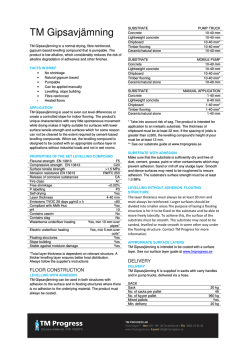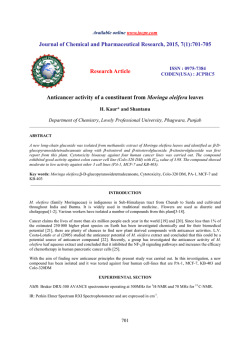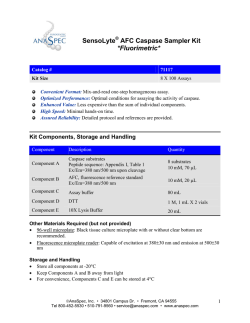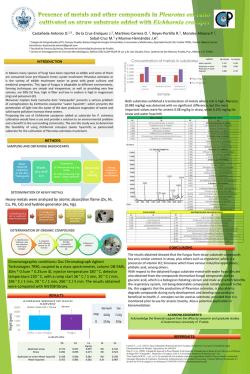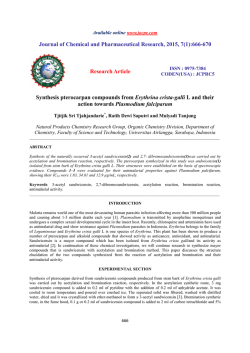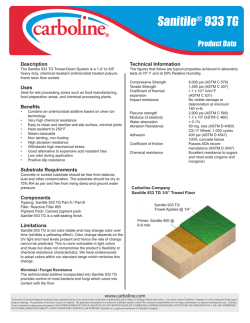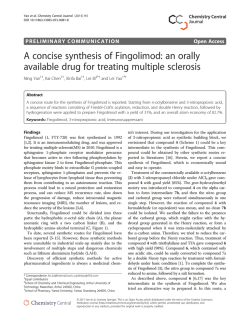
Product sheet
TM Industri K SUBSTRATE Concrete Ceramic/natural stone MOBILE PUMP 10-35 mm 10-35 mm TM Industri K is a is a self-drying, fibre-reinforced, cementbased levelling compound that is pumpable. The product is low-alkaline, which considerably reduces the risk of alkaline degradation of adhesives and other finishes. SUBSTRATE Concrete Ceramic/natural stone MANUAL APPLICATION 1-35 mm 1-35 mm FACTS IN BRIEF • Pumpable • Can be applied manually • Walkable after approx. 2 hours • Loadable after approx. 24 hours • Delivery by pump truck or in sacks • Paintable • Stable in the event of water damage • Compliant with AMA Hus APPLICATION TM Industri K is used to even out level differences or create a controlled slope for indoor flooring. When set, the levelling compound is designed to be coated with an appropriate surface layer in applications with load levels up to industrial load. PROPERTIES OF THE SET LEVELLING COMPOUND Flexural strength EN 13813 F10 Compressive strength EN 13813 C35 Surface tensile strength >2 MPa Abrasion resistance, steel castors RWA 100 Release of corrosive substances CT Fire class A1 Free shrinkage <0,03 % Self-drying Ja Layer thickness 10-35 mm Emissions TVOC 28 days µg/m2xh <10 Compliant with AMA Hus Ja pH 10,5-11 Contains casein No Contains slag No Waterborne underfloor heating Yes, min 10 mm over pipes* Electric underfloor heating Yes, min 5 mm over loops* Floating structures Yes, but not for industrial loads Sloping installation Yes Stable against moisture damage Yes *Total layer thickness is dependent on relevant structure. A thicker levelling layer ensures better heat distribution. Always follow the supplier's instructions FLOOR CONSTRUCTION LEVELLING WITH ADHESION TM Industri K is preferably used in structures with adhesion to the substrate as floating structures are not suitable for heavier loads. Contact TM Progress for more information: LEVELLING WITH ADHESION TO SUBSTRATE SUBSTRATE PUMP TRUCK Concrete 10-35 mm Ceramic/natural stone 10-35 mm SUBSTRATE WITH ADHESION Make sure that the substrate is sufficiently dry and free of dust, cement, grease, paint or other contaminants which may prevent adhesion. Sand or mill off any sludge layer. Smooth and dense surfaces may need to be roughened to ensure adhesion. The adhesion or surface strength of the substrate must be at least 1.5 MPa. LEVELLING WITHOUT ADHESION. FLOATING STRUCTURE The layer thickLevness must always be at least 30 mm. However, floating floor structures are not suitable for heavier loads. Contact TM Progress for more information: APPROPRIATE SURFACE LAYERS Surface layers should be applied within 5-10 days. Use of the self-drying properties and hence the resulting short time before application of the surface layer requires the surface layer to be non-susceptible to moisture and the underlying floor structure must be as dry as required for the surface layer before levelling takes place. See our surface layer guide at www.tmprogress.se DELIVERY DELIVERY TM Industri K is supplied in sacks with carry handles and in pump trucks, delivered via a hose. SACK Sack No. of sacks per pallet No. of kg per pallet Mixed pallets Min. delivery 20 kg 48 960 kg Yes 20 kg PUMP TRUCK Delivery by pump truck Min. delivery Yes 3000 kg PREPARATIONS TEMPERATURE The temperature is extremely important for successful results. 10 °C for the substrate, the material and the indoor temperature is the minimum level defined in AMA Hus 11. The temperature of the floor structure should be checked in plenty of time prior to priming. A higher temperature is very beneficial in terms of both quality and drying time. PRIMING Always prime the substrate with TM Primer 001 as instructed in the product sheet. The primer is applied 1-10 hours before levelling and must in any event be allowed to dry before levelling. However, the primer must not be left for more than 2 days as there is then a major risk of construction dust and other loose contaminants which may jeopardise adhesion settling on the primer. Note that thorough priming is particularly important for industrial flooring. Contact TM Progress for more information: TEMPERATURE,SUBSTRATE 10-25 °C TEMPERATURE,STORAGE 5-25 °C LEVELLING If the slope and curvature of the substrate deviates from the prescribed tolerance, the floor should be levelled using a spirit level or laser. Setting out height-adjusted level pins will allow you to ensure when laying the levelling compound that the layer thickness is sufficient to meet the tolerances. Note that level pins and suchlike may be visible through some surface layers. MIXING AND APPLICATION MIXING Always use clean water and clean equipment. When mixing in a bucket, measure out the right amount of water into the container, add the dry mortar and mix using a drilling machine fitted with a whisk or a mixer for at least two minutes. Check that the levelling compound is homogeneous, free-flowing, contains no lumps, is well mixed and free from separation. When defining a slope, reduce the water volume to ensure an appropriate consistency. Material required Temperature, dry mortar Storage time, dry mortar Water temperature Water requirement Mixing time Levelling EN 12706 Hose length, mobile pump 1.65 kg powder/sq m/mm 10-25 °C 6 months +5 – 20 °C 3.4-4 litres per 20 kg sack (17-20%) 2 minutes 135-145 mm Min. 60 metres APPLICATION Pour or pump out the ready-mixed levelling compound in widths on the substrate. Lay each new width right next to an old width as soon as possible so that the compound flows together to form a flat, even coating. Make the widths no more than about 10 metres wide by using TM side form strips. Work the levelling compound using a notched trowel or spiked roller in order to achieve maximum smoothness. Temperature, substrate Temperature, air Layer thickness Pot life Wet time Walkable after 10-25 °C 10-25 °C 5-35 mm 20 min 15 min 1 hour SUPPLEMENTARY WORK AND CLEANING The half-set levelling compound can easily be shaped or cut. Clean tool immediately with water. The set levelling compound can only be removed mechanically. DRYING AND COATABILITY DRYING AND COATABILITY The drying time of the levelling compound is affected by the layer thickness, the temperature of the floor structure and air and the relative humidity on the premises. Good ventilation on the premises is a prerequisite for effective drying. TM Industri K is self-drying, which means that the surface strength is quickly sufficient for coating and that the water in the levelling is bonded chemically during the setting process. The product can be coated within 1-3 days. However, surfaces designated for heavier loads require 5-10 days before laying the surface layer and starting to use the area. If the planned surface layer is unable to withstand moisture and it is necessary to wait for an appropriate RH, after 5-10 days the surface should be covered or treated with diluted primer (1+5) for the remainder of the drying time. A levelling compound can never be drier than its substrate and cannot deal with surplus moisture from it. The product can be laid on concrete with up to 95 % RH, but the self-drying function requires the relative moisture content in the underlying structure not to exceed the moisture content required for the planned surface layer. Note that the levelling compound is unable to withstand shrinkage movements or settling from the drying of the substrate. To prevent excessively fast drying and a risk of cracking, the levelling compound applied/laid must not be exposed to draughts, high temperature or direct sunlight. Moderate load Processing time Can be walked on after Coatable Capable of withstanding full load Time before underfloor heating Industrial load Processing time Can be walked on after Coatable Capable of withstanding full load Time before underfloor heating 15 min 1 hour 1-3 days 1 day per mm of layer thickness 1 day per mm of layer thickness (max. 35 mm) 15 min 1 hour 5-10 days 1 day per mm of layer thickness 1 day per mm of layer thickness (max. 35 mm) NOTE This product sheet aims to provide technical information on the product which we supply and to provide advice, guidelines and recommendations on its use where possible. We are responsible for the technical properties of the product as specified in the table above, but we cannot accept responsibility for local conditions and any consequences these may have for the end results. However, in our contracts we assure the quality of these factors as well. That said, we are unable to guarantee the quality of other products that may be used in the same structure. Always follow the relevant supplier's instructions for each material.
© Copyright 2024
